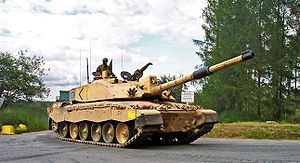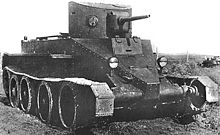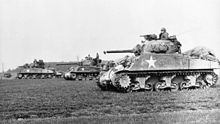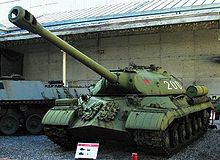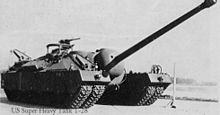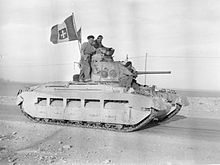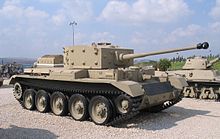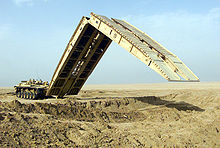- Tank classification
-
Tank classification is a taxonomy of identifying either the intended role or weight class of tanks. The classification by role was used primarily during the developmental stage of the national armoured forces, and referred to the doctrinal and force structure utility of the tanks based on design emphasis. The weight classification is used in the same way truck classification is used, and is intended to accommodate logistic requirements of the tanks.
An early division in the definition of roles was between Infantry tanks intended to focus on supporting infantry in the assault, and cruiser tanks intended for classic cavalry missions of exploitation, screening and reconnaissance.
As World War II progressed, tanks, heavier anti-tank guns, and tank-versus-tank combat became much more common on the battlefield. In order to survive, all tanks required an increase in armour protection and larger guns in order to defeat a similar "up-armouring" taking place on the enemy's own designs. The separation of "infantry" and "cruiser" roles generally disappeared and the "universal tank" started to take over. These were generally classified by weight. Weight classification was inconsistent between countries and eras. Light, medium, and heavy have other meanings than just weight, e.g., relating to gun size, the amount of armour, and, most importantly, tactical role.
The size classification system has been eliminated due to the world-wide adoption of the main battle tank. Modern tank designs favour a modular universal design eliminating these sorts of classifications from modern terminology. All main battle tanks are typically armed with weapons with similar characteristics but some may be armoured more than others.
Contents
Overview
Many classification systems have been used over the nearly one hundred years of their history. Classification has always been determined by the prevailing theories of armoured warfare, which have been altered in turn by rapid advances in technology. No one classification system works across all periods or all nations.
Tanks are often referred to by weight-based or role-based classification, such as 'light', 'medium' or 'heavy'. Many types are also described by their tactical role, which depends on contemporary military doctrine. For instance, 'infantry' and 'cruiser' tanks are British classifications of the 1930s and '40s; 'infantry', 'fast', and 'breakthrough' are contemporaneous Soviet types. Furthermore, expected weights for a given tank type vary over time; a medium tank of 1939 could weigh less than a light tank of 1945. Some examples:
- The British Mk II Matilda Infantry tank weighed as much as a German Panzer III or Panzer IV medium tank. Due to its heavy armour it had some of the traits of a heavy tank, but the gun was typical of a light or medium tank of the period.
- German Panzer IV tanks were often referred to as 'heavy' tanks in 1939 and 1940, because they had large-calibre armament (for the period), designed to attack infantry positions. However, the Panzer IV is usually regarded, and was primarily employed, as a medium tank.
- American M26 Pershing tanks were designated as 'heavy', despite being closer in performance to a Panzer V Panther medium tank than a Panzer VI Tiger heavy tank.
- Soviet T-34-85 medium tanks used 85 mm guns, comparable in calibre to 88 mm guns on Tiger heavy tanks. However, because of their armour and speed, and their weapons' strength, the two are ranked in different classes.
- Soviet IS-2 tanks were classified as heavy due to their strong armour and large 122 mm gun - although they weighed significantly less than a Tiger and about the same as a Panther, which was classified as medium.
British and Soviet tacticians up to the time of the Second World War classified tanks into three major roles: infantry, light, and cavalry. Infantry tanks supported infantry units, to integrally support dismounted infantry actions. Light tanks performed the traditional cavalry role of scouting and screening. Cavalry or "cruiser" tank units were meant to exploit breakthroughs and fight other armoured formations. Well into the 1930s, some generals[who?] saw tanks as merely serving in support roles for large conscript armies of foot soldiers and horse cavalry.
But even before the end of the First World War, some military theorists such as J.F.C. Fuller, and later Basil Liddell Hart, formulated a different image of combined-arms armoured warfare, featuring independent, professionally manned tank units. The conditions of the Treaty of Versailles forced Germany to build an armed forces essentially from scratch, allowing it to more easily abandon conservative theories and develop Blitzkrieg tactics.
The infantry and cavalry tank roles were abandoned by the end of the Second World War. World War II tanks were generally classified by weight and role: fast, relatively inexpensive light tanks for reconnaissance, general-purpose medium tanks, and slow heavy tanks for breakthroughs and long-range fire. Combat experience helped weed out unsuccessful designs.
After World War II, less expensive armoured cars and more specialised tracked vehicles gradually took over the reconnaissance role. Heavy tanks were shown to be incapable of keeping up with mobile warfare, but advances in engine, weapon, and armour technology allowed medium tanks to acquire the best characteristics of heavy tanks—the ultimate in mobility, firepower, and protection were rolled into the main battle tank (MBT).
Tank generations
Tanks are sometimes classified as belonging to a particular generation, although the actual definition and membership in these generations is not clearly defined. Soviet and Russian military planners organise tanks into a generation of tanks up to 1945, and four generations of main battle tanks,[1] while Canadian strategists organise main battle tanks into three generations.[2] The military of the People's Republic of China also recognises three generations of its own tanks.
Size
There were many names given to different tank types, and similar names did not assure similar design goals. Some light tanks were relatively slow, and some were fast. Some heavy tanks had large-calibre, low-velocity, anti-infantry bunker-busters, and some had high-velocity anti-tank guns.
In 1948 France, Canada, and America agreed to classify tanks as light gun, medium gun, or heavy gun. This lasted until 1957, when the Fourth Tripartite Armour Conference recommended to replace medium and heavy tanks with a single class — Main Battle Tanks.[3]
World War I
In World War I, the first tank, the Mark I, was designed for supporting infantry by crossing trenches and attacking machine-gun posts. Initially, there were two types with two roles: the 'males', armed with artillery guns and machine guns, and 'females', armed with machine guns only that supported the 'males'. The tanks that followed were described relative to it, including light, medium, and super-heavy tanks—for example, the light tank FT-17 (approximately 7 t / 15,000 lb.) and the medium Medium Mark A 'Whippet' (14 t / 31,360 lb.). By the end of the war, the Mark I (~30 t / 56-60,000 lb.) could be classified as a medium tank, and the Whippet as a light tank. Super-heavy breakthrough tanks such as the Char 2C (69 t / 158,000 lb.) or the K-Wagen (120 t / 275,000 lb.) were nearly completed before the war ended. In comparison, the current British MBT, the Challenger 2, weighs some 60 t (137,500 lb).
World War II
Tank models were developed before and during World War II according to different philosophies, with different combinations of armour, mobility, and armament. Each major nation developed its own doctrine of tank use, and therefore different tank models to suit. New doctrines explored the role of the tank as a fast-striking unit, while technological improvements led to the invention of engines, tracks, transmission, and suspension, which made tanks more reliable over a long distance. The ideas of the American inventor Walter Christie were important in establishing the fast tank concept.
Tank doctrine in the UK declared that one group of tanks would accompany infantry in a similar role to World War I, while another group of 'cruiser' tanks would then exploit a breakthrough, in a role similar to cavalry. In the USSR, 1930s' tank doctrine specified three groups of tanks: one 'breakthrough' tank in the infantry support role, one tactical breakthrough tank to clear the combat area, and a 'fast tank' for operational maneuver. In Germany, the ideas of Guderian established the need for unified tank formations, but with a mixture of armaments for differing roles.
In the U.S., doctrine evolved so that the main purpose of the tank was to provide infantry support and exploitation of breakthroughs. The antitank role was given to tank destroyers. There was no analog to the cruiser tank in pre-war US doctrine. There were those within the US Army which advocated a more modern force with tanks in the cavalry role, but their suggestions were not put into place by the time of the US's entry into World War II. These doctrinal differences are important when considering World War II tank classifications.
Light tank
Main article: Light tankLight tanks in World War II tended to be smaller, faster, and lighter vehicles, and cheaper to produce. The weight of a 'light' tank increased markedly during World War II. For example, the M24 Chaffee was a purpose-built light tank of late World War II, but weighed more than the Panzer III, a mainstay medium tank from 1939-43 but obsolete at the time the Chaffee was introduced. Some light tanks are able to move over land rapidly compared to heavier tanks and are maneuverable through obstacles such as jungle thickets, while maintaining lethality against enemy infantry. The Imperial Japanese Army exploited this ability of their light tanks during the Battle of Malaya. However, many other light tanks are no more mobile than their heavier cousins, in part because the emphasis on economy meant they often were powered by standard light truck engines rather than the larger, heavier, but much more powerful medium tank engines.
Light tanks were quite common at the start of World War II, being the main element of German, Polish and French formations in the Polish and French campaigns, but during the war were relegated to reconnaissance roles because of the increasing firepower of tanks and anti-tank weapons. Some were amphibious, and some, like the Tetrarch, were small enough to be airlifted to battle. They were often preferred over armoured cars for scouting. The Soviet Union even built an experimental winged tank which ultimately was never put to practical use.
The USSR experimented with giving infantry units detachments of light tanks (e.g., the T-70) to provide armoured support. The idea was a failure because the tanks' armour was readily penetrated by German anti-tank weapons, and their firepower was inadequate for fighting other tanks or destroying field fortifications. They were replaced in this role by the SU-76 self-propelled gun.
The French World War II-era light tank (Char Léger) types differed from other nations' light tanks of the period. Since they were intended to be used for infantry support rather than scouting, they were slower than most light tanks, giving it the weaknesses of the type, but with heavier armour. The French intended the AMR scout tanks (Automitrailleuses de Reconnaissance) and armoured cars (Automitrailleuses de Combat) for scouting and light combat roles.
Since World War II, light tanks have continued in the reconnaissance role, thanks to their modest cost and potential for amphibious capabilities, but have been supplemented by infantry carriers and armoured cars in many roles.
Medium tank
Medium tanks were neither the heaviest nor lightest in weight, and many of the designs had successful balance of firepower, mobility, protection, and endurance, and could often be adapted to a variety of roles. Medium tanks of the interwar period included the British Vickers Medium Mark II and the Soviet multi-turreted T-28.
There were medium tanks that focused on anti-infantry capabilities (such as in World War II: the Panzer IV short-barrel, and the M4 Sherman), and medium tanks which were more focused on the anti-tank role, mounting high-velocity tank guns. The French cavalry tanks (Chars de Cavalerie) focused on speed in addition to power and protection of the other designs. They were similar to what other countries called medium tanks.
When Soviet tank designers were preparing a successor to the BT Fast Tank series, they combined its excellent mobility with thick, sloped armour and the unprecedented firepower of a 76 mm high-velocity gun. The result was the T-34 medium tank, whose superbly balanced capabilities shocked the German Wehrmacht when it invaded the Soviet Union. The lessons of Blitzkrieg, first employed by the Germans and eventually adopted by other nations, found their best expression in formations of mutually-supporting medium tanks and motorised infantry. The traditional view of infantry and cavalry tank roles was rendered obsolete.
As well, the Soviet Union and the United States both benefited from their ability to manufacture a well-balanced medium tank in incredible numbers—about 57,000 T-34s and 49,000 M4 Sherman tanks were built during the war.
During and after the war, the roles of light tanks were gradually taken over by less-expensive armoured cars and specialised reconnaissance vehicles. Heavy tanks, having shown their limitations in World War II, experienced a limited arms race of progressively more heavily-armed and armoured designs, but these too were eventually phased out in favour of increasingly capable and flexible medium tanks. Simpler and more economical self-propelled guns, and later anti-tank guided missiles, came to fulfill fire-support and anti-tank roles, allowing tanks to become more specialised for mobile warfare.
Heavy tank
Main article: Heavy tankHeavy tanks were deployed to fulfill the need for a breakthrough tank, though in practice have been more useful in the defensive role than in the attack. Design goals have included attacking obstacles, creating breakthroughs, and engaging enemy armoured formations. They feature very heavy armour and weapons relative to lighter tanks, though they tend to push power plants to the limits. As a result they tend to be either underpowered and comparatively slow, or have engine and drive train problems from overworking their engines.
The first tank, the Mark I of World War I, was designed around this philosophy. So was the Char 2C, one of the largest tanks ever produced. At the start of World War II, the French and the Soviets were the only countries to have inventories of heavy tanks, such as the Char B1, T-35, and KV-1. The Matilda II infantry tank, though not as heavy as the others, had thicker armour than most tanks in service at the time. Later war examples were the German Tiger I and II, as well as the Soviet IS series. Note that "heavy" versus "medium" is more a question of tactical roles than weight; the Panther, for example, was a "medium" tank that outweighed most Allied "heavy" tanks.
Heavy tanks achieved their greatest successes both fighting other, lighter tanks, and destroying fortifications with their very large guns. Although it is often assumed that heavy tanks suffered inferior mobility to mediums, this was not always the case, as many of the more sophisticated heavy tank designs featured advanced suspension and transmission precisely to counteract this drawback. But the greatest drawback is cost which translates into production, resulting in short supplies. The German Tiger, for example, had similar speed and better terrain-handling characteristics when compared to the significantly lighter Panzer IV medium tank, albeit at the cost of low reliability and only 1,355 were produced compared to 58,000 Soviet T-34 and 40,000 American M4 Sherman medium tanks.
The immediate post-war period saw the final fielding of heavy tanks, including the US M103 heavy tank, the British FV214 Conqueror, and the French ARL 44, all in response to the Soviet heavy tanks of the period. The largest tank guns were approaching maximum calibre whose shell could still be handled by the crew, even using awkward two-part shells and propellants, which greatly slowed their rate of fire. Thanks to improved gun designs and fire control technology, postwar medium tanks were catching up to heavy tanks in firepower. The tactical value of heavy tanks thus declined to the point that no new designs were fielded; the heavily-armed mediums came to be known as the Main Battle Tank (MBTs). Less expensive self-propelled artillery pieces could fulfill the heavies' infantry support role.
Heavy tanks were finally rendered obsolete by anti-tank guided missiles and high explosive anti-tank (HEAT) ammunition. The much more flexible missiles are effective at ranges beyond a tank gun's range, and sheer armour mass was no longer a guarantee of survivability against the largest HEAT warheads of tank guns or missiles.
Super-heavy tank
There were a few rare tanks informally called "super-heavy tanks". As their name implies, most of these tanks were extremely heavy such as the impractical, Porsche-designed German Panzer VIII Maus of 200 tonnes weight. Super-heavy tanks featured very thick armour, and more powerful weapons than could be mounted on other vehicles.
Most of these super-heavy tanks only reached pre-prototype stage, while some never even left the drawing board, such as the 1000-tonne Landkreuzer P. 1000 Ratte, 1500- tonne Landkreuzer P. 1500 Monster and TG-5 tank designed by Edward Grote. World War II and the following post-war period[clarification needed] saw the quick zenith of super-heavy tank designs, with the conception of the German P-series tanks, British experimental Tortoise heavy assault tank (79 tonnes) and US T28 Super Heavy Tank (86 tonnes).
The super-heavy tank concept was short-lived, since these designs were simply too heavy to be of practical military value. Existing bridges and railroad flatcars couldn't sustain their weight, and would collapse; existing landing craft designs would also be unable to accommodate them. Ultimately, none of them entered series production or combat.
Modern
Light tank
Light tanks, such as the PT-76, continue to play an important role in tank warfare, however many are being replaced with IFVs and armoured cars. The light tank still fills an important niche in many armies, especially nations with airborne divisions, or those which do not have the resources and funding to maintain a large number of main battle tanks. Additionally, they have important advantages over heavier tanks in Southeast Asia and other nations in the Equatorial region. Their size allows them to maneuver through thick rainforests and their weight reduces the risk of getting stuck in muddy terrain. This makes the light tank the preferred choice for infantry support in Equatorial nations.
Main battle tank
Advances in tank design, armour, and engine technology allowed tank designers to increase the capabilities of tanks significantly without always resorting to heavier designs, although weights did gradually increase. High explosive anti-tank (HEAT) ammunition was a threat to tanks and could penetrate steel armour thicker than was practical to put on a tank. Advances such as the British-designed Chobham armour limit the effectiveness of weaker HEAT rounds, but the vulnerability still remained.
On 7 November 1950, the US Ordnance Committee Minutes (OCM), order #33476, ceased utilizing the terms heavy, medium, and light tanks and redesignated tanks by the gun system, e.g. 90 mm Gun Tank M48 Patton, etc.[4] with heavy gun tanks (120 mm), medium gun tanks (90 mm), and light gun tanks (76 mm), although these gun terms were often still shortened to simply heavy, medium, and light tanks.
The term "main battle tank", in the US, was first generally applied to the US M60 main battle tank in 1960,[4] coinciding with the deactivation of the US Army's last M103 heavy tank battalion, the 2nd Battalion, 33rd Armor Regiment, and the delivery of the M60 to US units in Europe. The M60, armed with a 105mm main gun, was to be an all purpose tank, armed and protected as a heavy tank, but with the mobility of the medium tank.[4] The MBT would form the backbone of modern ground forces. It is armed and armoured to face as many kinds of threats as possible, but especially direct hits from other tanks and lighter infantry anti-tank weapons. However, the threats to MBTs on a modern battlefield are numerous.
 United States Army M1A2 Abrams main battle tank, fitted with reactive armor, as per the recent TUSK refit.
United States Army M1A2 Abrams main battle tank, fitted with reactive armor, as per the recent TUSK refit.
Many Cold War MBTs evolved more or less directly from late World War II medium tank designs. The US Patton series of tanks was a series of successive evolutions of the M26 Pershing, for example, and the Soviet T54/55 was a direct descendant of the T-44, itself an evolution of the T-34. This meant that many MBTs retained something of their "medium tank" origins in terms of their balance of size, weight, mobility, and protection. However, in the 1960s and 1970s, a generation of purpose-designed main battle tanks appeared, starting with the British Chieftain tank. These vehicles are less obviously influenced by wartime templates (the Chieftain, for example), weighing as much as a World War II Tiger tank and possessing far greater firepower and armour, while retaining the mobility of the previous Centurion design. Similarly, the US M1 Abrams series, the German Leopard 2, the British Challenger, French Leclerc and Russian T-90 tanks are all main battle tanks. The defining feature of the main battle tank type is neither its weight, mobility, nor firepower, but instead the idea that only one type of heavily armoured vehicle is required to carry out the roles of breakthrough, exploitation and infantry support.
Even heavily armoured MBTs are vulnerable to anti-tank weapons, which are often designed to attack their most vulnerable locations: the top, the bottom, and the tracks. Tanks also retain much of their vulnerability to artillery fire and mines. A tank's heaviest armour is concentrated on its front, leaving its sides and rear less well protected.
The response was to focus on the traits that allowed the tank to survive; protection, mobility and firepower. The amount of armour added was usually sufficient to stop at least previous-generation projectiles from penetrating. Armour on more advanced Western MBTs has been shown to deflect current generation projectiles at least their frontal armour, but there is little public information on the armour levels of the latest MBTs, as such information is generally kept secret.
Role
World War II
Infantry tank
The idea for this tank was developed during World War I by the British and French. The infantry tank was designed to work in concert with infantry in the assault, moving mostly at a walking pace, which required it to carry heavy armour to survive defensive fire. Its main purpose would have been to clear the battlefield of obstacles, suppress or destroy defenders, and protect the infantry on their advance into and through enemy lines by giving mobile overwatch and cover.
The British came back to the concept in the pre-Second World War era. The infantry tank did not need to be fast so it could carry more armour. In order to support the infantry it had to have a gun that was an effective anti-tank weapon.
One of the best-known infantry tanks was the Matilda II of World War II. Its armour was thick enough to stop all but the most powerful anti-tank rounds of the period. Its QF 2-pounder gun was sufficient to take on most light and medium tanks of the early war, but could not fire high-explosive ammunition. It should not be confused with the Matilda Mk I, also an infantry tank, which however was armed with only a machine gun. The Churchill and Valentine infantry tanks were also successful models, some of which mounted heavier guns like the QF 6-pounder.
Cruiser tank
A cruiser tank, or cavalry tank, was designed to move fast and exploit penetrations of the enemy front. The idea originated in "Plan 1919", a British plan to break the trench deadlock of World War I in part via the use of high-speed tanks. This concept was later implemented in the "fast tanks" pioneered by Walter Christie.
They were used by the United Kingdom during World War II. Cruiser tanks were designed to complement infantry tanks, exploiting gains made by the latter to attack and disrupt the enemy rear areas. In order to give them the required speed, cruiser designs sacrificed armour compared to the infantry tanks.
At first they were armed with QF 2-pounder (40 mm) anti-tank guns that although capable of penetrating enemy armour were not effective against infantry or towed anti-tank weaponry as they did not use a High Explosive shell. The 2 pounder was followed by the 6 pounder (57 mm) as it became available, though the delay in the next generation of cruiser tanks meant that an older design was modified to take it. The British cruiser tanks benefitted from the development of an effective engine. Following Christie's practice of a lightweight high power engine - generally to be found from aircraft engine manufacturers - the 340 hp Liberty engine of the first Christie suspension cruisers was followed by the 600 hp Rolls Royce Meteor.
Early cruiser tank designs, such as the A9 and A10, introduced pending the first Christie suspension designs were largely replaced by heavier cruiser designs such as the Crusader series, though in some cases by more modern light scouting tanks, such as the US M3 Stuart. Starting in 1942 British cruiser tank units were reequipped with American medium tanks (the M3 Grant and later M4 Sherman) with the cruisers being used for flanking and reconnaissance. In 1944, in replacing their tanks, a few units were partially converted back to British equipment: the Cromwell cruiser tank, which had a similar gun to the Sherman,[nb 1] similar armour, but significantly more speed. The final development of the British cruiser tank line was the Comet, introduced in late 1944, which was an effective medium tank on a par with the German Panther. Leading on from the Comet, the Centurion, would be one of the first MBTs.
The Soviet fast tank (bistrokhodniy tank, or BT tank) classification also came out of the infantry/cavalry concept of armoured warfare and formed the basis for the British cruisers after 1936. The T-34 was a development of this line of tanks as well, though their armament, armour, and all-round capability places them firmly in the medium tank category.
Modern
Specialist tank
Tanks have often been modified for special purposes. The most common is to provide armoured capability for combat engineers. These include tanks carrying large-calibre demolition guns, with flails or ploughs for mine-clearing, or flame tanks armed with flamethrowers. The tank occasionally may lose its weapons and the chassis alone may be used, as in bridge-laying tanks.
Notable among wartime examples which formed Hobart's Funnies was the Churchill AVRE, which was equipped with a weapon for destroying bunkers and other fortifications but also able to mount other equipment.
Another important modification was the amphibious tank, such as the Sherman Duplex Drive (DD). These designs were modified with waterproofing and propulsion systems, to be able to traverse open water. Their most notable usage was on D-Day.
Many specialist tank roles have been assigned to other vehicle types, though many tank chassis are still used for a wide variety of vehicles, ranging from anti-aircraft roles to bridge layers.
Unmodified tanks can be fitted with equipment, such as mine-clearing ploughs, to give them ancillary roles.
See also
- Armoured fighting vehicle
- Comparison of early World War II tanks
- History of the tank
- Hull-down
- List of main battle tanks by country
- List of main battle tanks by generation
- G-numbers
Notes
- Notes
- ^ A modified 6 pounder that fired the same 75 mm ammunition
- Citations
- ^ "The Soviets saw tank generations in this manner: 1920-1945, first generation; 1946-1960, second generation; 1961-1980, third generation; and 1981-present, fourth generation. Since the last really new tank design, the T-80, came out in 1976, they feel that they have not produced a true Fourth Generation Tank Design. In comparison, they count the M1 Abrams, Challenger, and Leopard 2 as Fourth Generation and the LeClerc as Fifth Generation." —Sewell 1988, note 1.
- ^ "The Canadian Directorate of Land Strategic Concept defines three generations of Main Battle Tanks. The first generation of post World War II Main Battle Tanks includes the U.S. M48/M60, the German Leopard 1 and the British Centurion and Chieftain. The second generation includes most of the 120mm Main Battle Tanks such as the American M1A1, the German Leopard 2 and the British Challenger. As for the third generation Main Battle Tank, they include the latest 'digital' tank such as the French Leclerc and perhaps the American M1A2 and the German Leopard 2A5." —Lamontagne 2003, pp 7–8.
- ^ Bud, Robert; Gummett, Philip, eds (2002). Cold war, hot science: applied research in Britain's defence laboratories, 1945-1990. NMSI Trading Ltd. ISBN 1-900747-47-2. p.123
- ^ a b c Hunnicutt[page needed]
References
- Lamontagne, J.G. Pierre (2003). Are the Days of the Main Battle Tank Over?. North York, Ontario: Canadian Forces College. (PDF)
- Sewell, Stephen ‘Cookie’ (1998). “Why Three tanks?”, in Armor vol 108, no 4, p 21. Fort Knox, KY: US Army armor Center.
- Hunnicutt, R. P. (1984). "Patton: A History of the American Main Battle Tank." Presidio Press. ISBN 0-89141-230-1.
External links
Categories:- Tanks by type
- Armoured warfare
Wikimedia Foundation. 2010.

